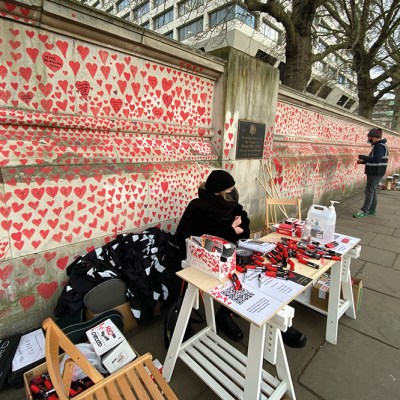From the April 2022 issue of Apollo. Preview and subscribe here.
The visual art world is getting textier and textier. Few institutional exhibitions now come without captioning lengthier than a parliamentary report. The more self-important commercial galleries publish weighty catalogues, show by show, to communicate museum-like gravitas and spin saleable tales around their artists. Small independent spaces assert intellect by commissioning esoteric essays, and invite artists to supply reading lists as a primer for approaching their work. We are so awash in words that the art can feel like mere illustration bobbing about within a heaving ocean of text.
Truly, what a time to be a writer in the visual arts! Not only is business booming, but all of that troubling, enigmatic art stuff now comes niftily translated into a formal language (actual written English) that many of us secretly feel more comfortable with. Some of my younger colleagues cry out for exhibition texts. They wish to reflect on the art with clarity, to think correct thoughts about it, to avoid creeping doubts and suspicions, to be soothed by words.
This craving for the reassurance of text played on my mind after two recent conversations with artists. Visiting Hew Locke’s studio in south London while he worked on a commission for Tate Britain’s Duveen Galleries, we kept circling back to his desire to complicate rather than simplify, to add things to the mix rather than allow a work to be reduced for neat interpretation. ‘In the past I would have felt like I needed to explain this, completely crystal clear, to my audience,’ Locke said. Now he was willing to make space for subtlety and doubt, even to the point of opening the work up to misunderstanding.
To place a comprehensive interpretative text alongside a work is, to an extent, to close it off. It suggests that there is a stable meaning to the work, and a correct way to look at and understand it. This kind of idea used to be wildly unfashionable. Back in the ‘death of the author’ days it was the done thing to talk about the audience ‘completing’ the work, which was a fancy way of saying that everyone brought their own experience and point of view into the gallery, so they’d see things differently, and that was OK. The cultural mood has long since flipped, and the author/artist is reasserting not only their liveliness and their complex identity, but in some cases also their desire for understanding.
Visitors to the Rijksmuseum with ‘Birds in a Park’ (1686) by Melchior d’Hondecoeter (1636–95) in the background. Photo: BTEU/RKMLGE/Alamy Stock Photo

Misunderstanding – getting the wrong end of the stick – is seen as profoundly shameful rather than an acceptable hazard. Since so much of our interaction with art is now performed through social media channels, the prospect of failing to say or write the correct thing about an artwork has become freighted with anxiety and the spectre of public humiliation.
Last year I made an idiot of myself in a broadcast interview with a French artist when I asked whether the title of her recent series of dripping red watercolours – Wet Job – referred to covert assassination. She stared back at me in blank horror. (The series was inspired by pumping breast milk for a baby. Apparently I watch too many dodgy thrillers.) Shit happens. The real danger lies in becoming morbidly nervous of slipping up and misreading something. In constantly needing to be reassured by text, we lose both roving curiosity and the ability to interpret our visual environment.
The second conversation was with Lubaina Himid, whose exhibition at Tate Modern carries no captioning or guiding texts at all. Instead Himid has painted a series of questions on the walls, which you might apply to yourself, or to the way you think about the artworks. You are offered no right way to approach the show. This lack of text apparently left some writer colleagues flailing: I witnessed one critic rather tersely asking a press officer to explain works to her. Talking to Himid a few weeks later, she said that she wanted to create a space for ‘visual thinking’.
It is a commonplace to describe ours as a visual age. Certainly it is an age saturated with images, but I’m not sure we’re always good at interpreting them, if only because they come at us so fast. How might we instead think visually? In sketching an idea perhaps. Or in opening ourselves to the possibility that there are forms of information and intelligence that cannot be captured in text but instead communicate with us as visual beings. If this were not the case, why bother making art? (Or, indeed, an exhibition rather than a book?) An artwork that stands no chance of communicating without a text is failing as a visual artwork: the hierarchy has flipped, transforming it into an adjunct to a piece of writing.
There are other reasons, as an artist, why you might prefer to show your work without captions and other forms of textual guidance. Language is never neutral, but, like art, is always modified by its context. Text is one of the ways in which an institution frames an artwork, marking it out as part of its cultural territory. The voice of the exhibition texts is an institutional voice, given form by curators and the interpretation team. If an artist has an ambivalent relationship with an institution – because of a history of exclusion, shoddy employment practices or dubious donors, perhaps – she or he may prefer to minimise the ways in which it is permitted to assert its dominion over their art.
From the April 2022 issue of Apollo. Preview and subscribe here.



